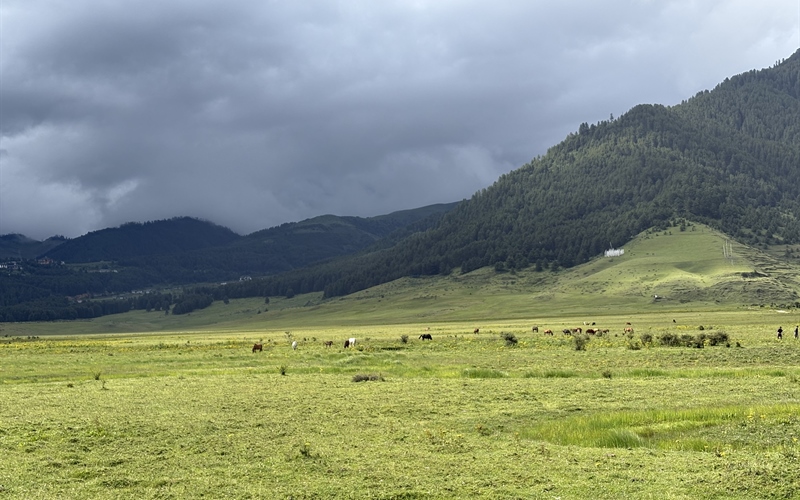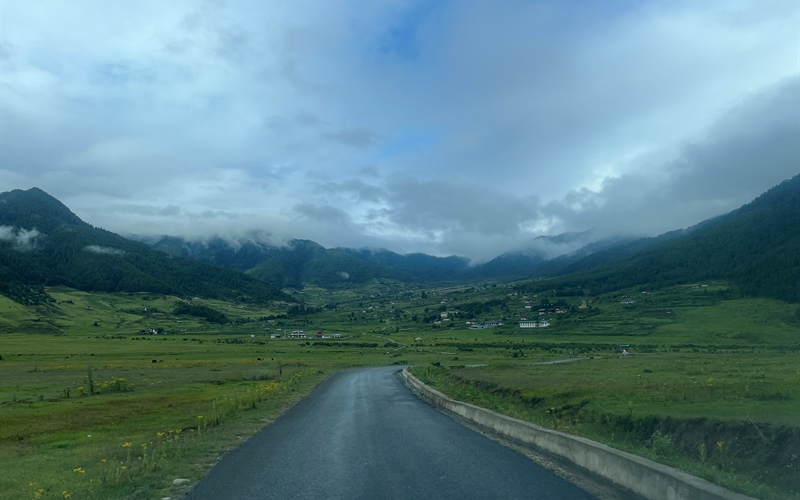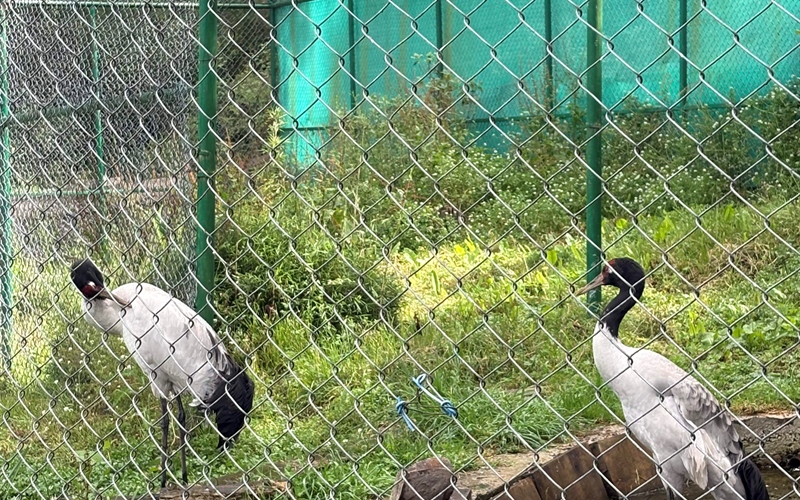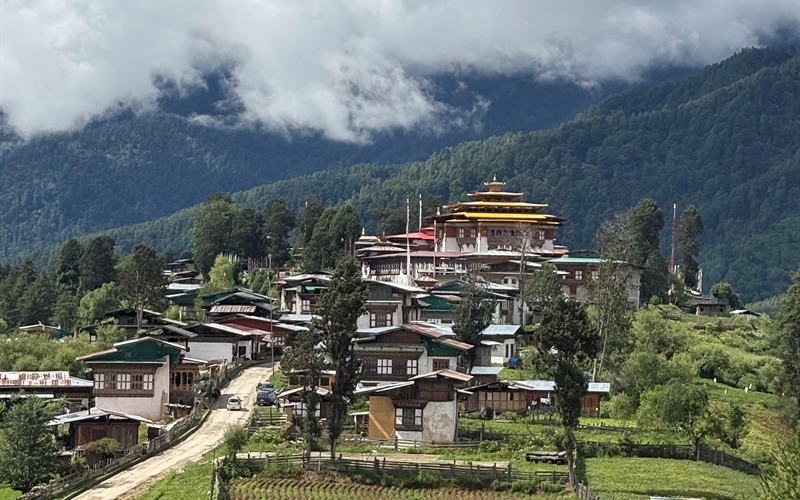Gangtey-Phobji: A Thriving Haven for Cranes and Eco-Tourism
Gangtey-Phobji, Bhutan’s largest Ramsar site, is a vital wetland sanctuary for the endangered black-necked cranes that migrate here each winter. Beyond its ecological importance, the valley has blossomed into a model for sustainable eco-tourism, offering visitors a chance to experience pristine nature and rich local culture. Its conservation success reflects Bhutan’s deep-rooted harmony between environmental preservation and community-based tourism.

The journey to Gangtey-Phobji is as breathtaking as the valley itself. The road, now fully blacktopped, meanders gently through a lush green forest of pine and rhododendron. As you ascend through the cool, shaded woods, occasional rays of sunlight filter through the thick canopy, dancing on the road. The air grows crisper, filled with the earthy scent of moss and damp leaves. Then, as you begin your descent, the forest opens up suddenly to reveal a breathtaking panorama—a vast, bowl-shaped valley stretching out below.
The sweeping plain, dotted with wetlands, is flanked by gentle hills and clusters of traditional Bhutanese houses scattered like pearls across the landscape. With their whitewashed walls, wooden windows, and intricate cornices, these homes seem to grow organically from the earth, each resting peacefully in harmony with the land. The moment is serene—quiet except for the sound of wind brushing through the trees.

Gangtey-Phobji in Wangduephodrang, western Bhutan, is the country’s largest Ramsar (wetland) site and the main winter roosting ground for the endangered black-necked cranes. Because of this, the valley attracts many visitors—both local and international—who come to see the cranes in their natural habitat.
Rise of eco-tourism and community-based tourism
This growing interest in the cranes has helped boost tourism in the area, bringing economic benefits to local communities through homestays, guided tours, and the sale of local products.
In 1992, Gangtey Gewog had just one village homestay catering services to the tourists. Over the years, this number has grown significantly, with more than 30 homestays now operating with majority of the homestays located in Gangtey with about few in Phobjikha.
 There are 21 high-end hotels and resorts in the two gewogs of which three are in Phobjikha highlighting the valley’s growing appeal and its potential for sustainable tourism development.
There are 21 high-end hotels and resorts in the two gewogs of which three are in Phobjikha highlighting the valley’s growing appeal and its potential for sustainable tourism development.
Thanks to the bird, businesses in these two gewogs are thriving even during the off-season, with a steady flow of local visitors.
A crucial habitat for Black-Necked Cranes
During the 2024–2025 season, the Gangtey-Phobji valley recorded a total of 640 black-necked cranes—565 adults and 75 juveniles—making it the largest roosting site in the country. In comparison, Khotokha, located on the other side of the valley, saw just two cranes. Boomdeling in Trashiyangtse in east recorded 52 cranes, while Chumey and Tang valleys in Bumthang in central Bhutan each received two. Lhuentse, in eastern Bhutan, recorded three cranes.
Black-necked cranes are native to parts of central China and northern India, and are also found in the Himalayan region, including Bhutan. Each winter, they migrate from the higher Tibetan plateau to the warmer valleys of Bhutan.

A black-necked crane festival is held every year in the premises of the Gangtey monastery on November 11 to welcome the cranes, which start arriving in late October to mid February.
The Royal Society for Protection of Nature (RSPN) began recording black-necked crane sightings during the 1986–1987 winter season.
Designation as a Ramsar site and its implications
Approximately 975 hectares of wetlands from the two gewogs of Gangtey and Phobji in Wangdue have been designated as a Ramsar site, making it the third such site in Bhutan and the second in the district. The other Ramsar site is located in Khotokha also in Wangdue, while the third is in Bumdeling, Trashiyangtse in eastern Bhutan.
The inclusion of Gangtey and Phobjikha gewogs as Ramsar sites marks another milestone in Bhutan’s conservation efforts. It not only enhances the protection of the region’s rich biodiversity but also contributes to sustainable income generation for local communities through eco-tourism and nature-based livelihoods.
Parliament approved the proposal of the three sites as Ramsar sites in 2012. Bhutan became the 161st contracting party to the Ramsar Convention in the same year.
Wetlands in Bhutan consist of a variety of ecosystems, including lakes, rivers and streams. These functional wetlands are vital components of the watershed, playing a crucial role in maintaining ecological balance.
The Ramsar Convention, the oldest global environment agreement, was adopted in Ramsar, Iran in February 1971. It promotes the wise-use and conservation of water and wetlands.
Conservation efforts, stakeholder engagement and shared responsibility
In November last year, to protect and manage the wetland, the Ministry of Energy and Natural Resources launched a ten-year Action Plan which includes more than 40 activities in the Action Plan including the implementation of spring shed management, landfill development and waste segregation.
A three-day workshop was held on 1-3 July 2025 in Phobji gewog to bring together government officials, conservationists, local leaders, and private stakeholders to chart a new course for the valley’s conservation. Participants shared their roles and responsibilities in preserving the wetland.
The workshop aims to design a sustainable financing model based on shared responsibility. Central to this approach is integrating financial contributions from private sector actors—such as tourism operators and hydropower companies who benefit from the site’s ecosystem services—into public conservation efforts. Additionally, it seeks to incentivize local communities to adopt wetland-friendly practices, including ecotourism, organic farming, and habitat restoration.

A model for conservation-based development
As more people become interested in the black-necked cranes, Gangtey-Phobji has become a shining example of how conservation and community-based tourism can work together. The presence of the endangered cranes draws visitors from across the country and beyond, helping local people earn a living through homestays, guiding, and selling local products.
However, both environmentalists and local residents are concerned about the future of the valley. They worry that if the Ramsar site is not properly protected, the area—which is now one of the most popular tourist destinations in the country—could lose its natural beauty and significance.
Major threats to the site include stray cattle, wild dogs, and increasing waste, all of which could disturb the cranes and damage their fragile habitat. Protecting the valley is crucial not just for the cranes, but for the people who depend on its continued health and appeal.





